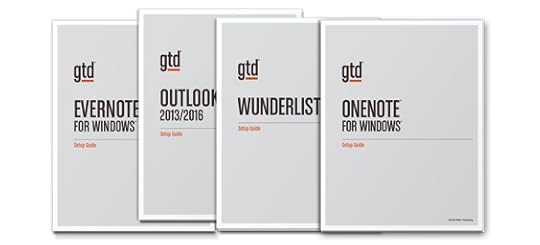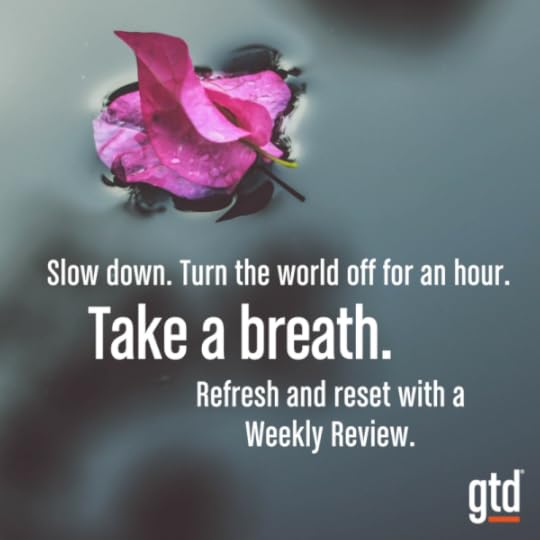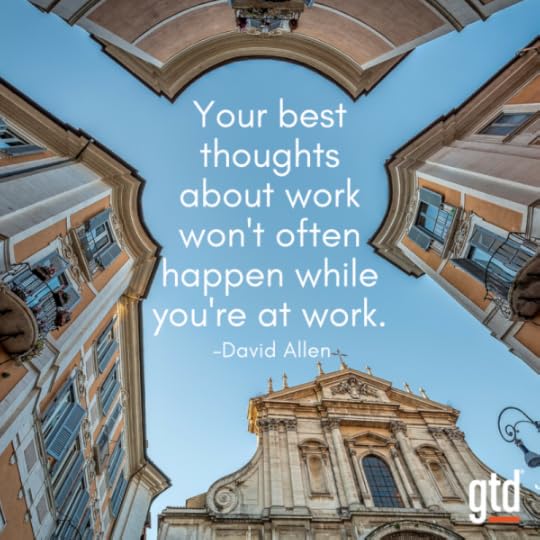David Allen's Blog, page 46
June 5, 2017
The dark side of collaborative cultures
 yours?” is unfortunately not in the common vocabulary of many such organizations. There is a sense that that would be impolite. “We’re all in this together” is a worthy sentiment, but seldom a reality in the hard-nosed, day-to-day world of work. Too many meetings end with a vague feeling among the players that something ought to happen, and hope that it’s not their personal job to make it so.
yours?” is unfortunately not in the common vocabulary of many such organizations. There is a sense that that would be impolite. “We’re all in this together” is a worthy sentiment, but seldom a reality in the hard-nosed, day-to-day world of work. Too many meetings end with a vague feeling among the players that something ought to happen, and hope that it’s not their personal job to make it so.The way I see it, what’s truly impolite is allowing people to walk away from discussions unclear. Real togetherness of a group is reflected by the responsibility that all take for defining real things to do and the specific people assigned to do them, so everyone is freed of the angst of still-undecided actions.
–David Allen, Getting Things Done, pages 262-263.
Here’s your challenge GTD practitioners: At the end of your next meeting, be the one to hold the group accountable for asking, “What are the next actions from this meeting and who is going to own them?”
June 1, 2017
Speeding up by slowing down…
I want to talk about one of the more mysterious best practices in the GTD®methodology: the art of speeding up by slowing down.
I am making the assumption that all of you reading this are on some track of improvement and growth to begin with. I mean, why speed up, instead of slow down, as an end-result? If we were here to merely fulfill entropy, the thicker, duller, slower, and generally more unconscious we became, the more on track we would experience ourselves. I have to admit I do have some component inside of me that seems to align with that—my comedy team of Sloth and Indolence, with their cute little assistant, Gravity. Pretty seductive, especially as I move into my later years, to give in to that siren’s call.
There is a more dynamic and more “real” part of me, though. It is naturally buoyant, has direction, is continually expansive and is in upward movement. The trick is how to maximize my alignment with that. If someone asked me whether I would consider expressing that with more effort instead of less, I would say, no, I’m not interested. (For me, increasing productivity means getting a result with as little effort as possible.) But if what we’re getting to here is how to truly access more and more of that refreshing, rewarding, and fulfilling aspect of ourselves, is “working harder” required to get there…? No.
One of the subtlest ways that positive energy retreats from us is in our busy-ness. Losing perspective in trying to control everything, finish it all, fix it all—all at once. It shows up in ways like practicing Getting Things Done® out of frustration instead of inspiration, or helping yourself and others out of compulsion, not compassion.
One of the greatest lessons I have learned and continually must practice is that in order to really be in control, I must surrender. In the martial arts things must be held lightly. Grabbing too tight, whether it’s my muscles, my ego, my trowel, or my lists of projects and actions, can be dangerous and ultimately ineffective. I must at a moment’s notice be ready to let go, walk away from it all, and do nothing. Nothing at all. As a matter of fact, your ability to do nothing—to be idle, to daydream, to nap peacefully, to give yourself permission for 100% zoning out—is a hallmark of GTD maturity. And if you don’t believe me, just read the plethora of new data from the cognitive scientists about the need for the brain to rest—daily. That’s a bit tough to do, though, unless you’re REALLY onto the GTD game.
This essay appeared in David Allen’s Productive Living Newsletter. Subscribe for free here.
May 26, 2017
Managing projects with GTD
Having a complete and current projects list is one of the cornerstones to GTD mastery. To support you in getting there, here are  10 keys to defining and managing projects:
10 keys to defining and managing projects:
1. Projects are defined as outcomes that will require more than one action step to complete and that you can mark off as finished in the next 12 months.
2. Think of your Projects list as a current table of contents of the current outcomes on your plate.
3. Most people have 10-100 current projects, personally and professionally.
4. Current projects have at least one next action, waiting for, or calendar action, in order to be considered current.
5. Projects that have no current next action, waiting for, or calendar action are either no longer projects for you, or should be incubated to Someday/Maybe.
6. Future actions (i.e., actions that are dependent on something else happening first) do not go on the Next Actions lists until you can take action on them. They get stored with project plans.
7. The Projects list and project plans are typically reviewed in your GTD Weekly Review, ensuring each project has at least one current next action, waiting for, or calendar item.
8. It’s fine to have multiple next actions on any given project, as long as they are parallel and not sequential actions (e.g., “Buy stamps” and “Mail invitations” would not both be on Next Actions lists for the “Put on Party for David” project given that you need to buy the stamps before you can mail the invitations).
9. Projects are listed by the outcome you will achieve when you can mark it as done (what will be true?).
10. Effective project names motivate you toward the outcome you wish to achieve, and give you clear direction about what you are trying to accomplish.
How well are you doing on these? Where do you have any gaps? What is going well for you?
May 24, 2017
GTD Setup Guides
Our GTD Setup Guides give you step-by-step coaching on applying GTD to some of the best software tools out there. We currently have Guides for:
Wunderlist
OmniFocus
Outlook for Windows
Outlook for Mac
iPhone/iPad
OneNote for Windows
Evernote for Windows
Evernote for Mac
Lotus Notes
Google Apps
You can get them and see samples here.

What are we missing? What Guide should we write next? (No promises, as every tool has to pass our rigorous vetting process, but we’re always open to suggestions!)
May 23, 2017
Episode #30 – David Allen GTD® Keynote in Milan – Part Two
In this conclusion of a two-part episode, David Allen shares an in-depth, sweeping overview of GTD® to an audience in Milan, Italy. Learn best practices, as well as what you can expect to have happen in your life once you start applying them.
Listen Now
Subscribe or Download
May 3, 2017
Episode #29 – David Allen GTD® Keynote in Milan – Part One
In this first installment of a two-part episode, David Allen shares an in-depth, sweeping overview of GTD® to an audience in Milan, Italy. Learn best practices, as well as what you can expect to have happen in your life once you start applying them.
Listen Now
Subscribe or Download
May 2, 2017
Managing Work on a Vacation
QUESTION: While on vacation, how do you juggle work and play? How much time should you allot each day of your vacation to  reading business email, checking up on projects, etc.? What’s the best balance of work and play? When is the best time of the day to spend on work? What organizational tools should you always bring along on your vacation?
reading business email, checking up on projects, etc.? What’s the best balance of work and play? When is the best time of the day to spend on work? What organizational tools should you always bring along on your vacation?
DAVID ALLEN: My main purpose for a vacation is to change pace and environment to refresh perspectives and energies. Things that support that are on purpose. Things that don’t, aren’t. I like to think of vacation as re-creation, i.e. an opportunity to shift gears and balance my activity and focus mix (mental, physical, emotional, spiritual, social, relationships, family, etc.) If I’ve been spending a lot of energy thinking, writing, and speaking, then I want to spend some time getting physical–going for walks, exploring, swimming, jogging, etc. If I’ve been engaged in lots of physical work, then I want to read adventure novels, do some creative writing, and just hang out and socialize. Sometimes, when I’ve really been in the turbo fast lane for a while, I just like to do nothing, with a vengeance!
The main thing I want to keep on a vacation is a clear head–lack of distraction. That should be the criterion for how much of what kind of “work” to take with me or to stay connected and current with. If I’m lying on the beach and I keep thinking about what’s in voicemail or email, then I’d better check it so I can tan with a clear head. There’s a fine line, though, between checking in with the office to stay clear, and checking in with the office as an addiction or comfort zone of the pressure and pace of professional engagement. Because most people have some version of that habit, I would suggest erring toward the unplugged side of the equation. But if you must, to keep a clear deck, then of course do them as soon as you can in the day so that all those things can be put to bed early.
Many times we actually can afford to take off for mini-vacations, not constrained to “be in the office”, simply because we have the ability to be in touch from wherever, handling the necessities of our commitments with our clients and companies. Complaining about “having to do work” in those situations is a bit absurd. I have made business calls from my sailboat, so that I could actually go out sailing all day. You do as much as you need to do, to be able to keep doing what you’re doing!
Some specific suggestions:
1. The last place in the world to have a thought twice is on vacation. That’s why you should always have at least a low-tech “capture” kind of tool with you, even in the most remote places, doing the most remote things. I have a small wallet for credit cards and driver’s license that also has a tiny notepad and pen. I may not process the note (decide actions and input information) until I’m back in the groove, but the potential value that the thought might add is not lost. I also travel with a file folder or large envelope labeled “IN” for tossing notes, business cards, receipts, etc. for dealing with back at the office. The more senior and sophisticated your professional roles, the more likely your best thoughts about work won’t happen at work! They may happen on the vacation. And invariably people meet others to expand their network, and get new ideas and good information while socializing. And if you’re traveling it’s great to keep track of places to go, things to do, in case you want to go there again. If a key benefit of recreation is to get a fresh perspective, then protect your investment and be ready to take advantage of it’s outputs.
2. It is common sense to do your best before you start a vacation to catch up, clean up, and get proactive and current in all your work-related agreements and commitments, handling all the details in plenty of time. Be sure that you identify “Vacation” as a project as soon as it’s on your radar, and that you continue to define and complete all the action steps as soon as they can be done. Too many people need half their vacation to recover from the last two days before they leave!
3. If you have support and admin staff, give them relevant contact information and clarify what might constitute an “emergency” ahead of time to use it, and allow them to filter all communications.
4. Block out at least a full day or two on your calendar for catching up when you return. It is just shy of stupid to not prepare ahead of time for the invariable accumulated pile of details to adjudicate.
In conclusion, there’s nothing inherently good or bad about being involved with professional things on a vacation. It all depends on the many variables in your situation. But the assumption that work and fun are mutually exclusive is not a healthy one. If you have to have a vacation because your job is too stressful or no fun, you might want to change jobs, career, or your mindset about it all.
May 1, 2017
Refresh and reset with the Weekly Review
April 24, 2017
April 12, 2017
10 Tips for Success with GTD
I was reading a great article about creating fitness habits and realized every key point the author made about exercise could be  applied to GTD®—especially for anyone still trying to get their systems off the ground and build sustainable habits. Inspired by that article, here are 10 easy tips for success with GTD:
applied to GTD®—especially for anyone still trying to get their systems off the ground and build sustainable habits. Inspired by that article, here are 10 easy tips for success with GTD:
1. Start Small
There is a lot that makes up the Getting Things Done® methodology. But that doesn’t mean you need to learn or master it all, all at once. Start with the master moves, like:
Write down everything that grabs your attention when it shows up (supporting the idea that your mind is better used to have ideas, not hold them).
Try the Two-Minute Rule, which would mean handling things that take less than two minutes to finish when they show up.
Make sure you really understand the 5 steps to mastering workflow—those are the keys to how everything gets done in your life and are the backbone to GTD.
2. Set Easy Rules
Create a game you can win with GTD. Instead of saying you’re going to get your inbox to zero every day, start with an easier goal of once a week. Instead of saying you’re going to do the GTD Weekly Review every week for the next 10 years, try scheduling just the next one. And when you’ve done that one, book the next one after that.
3. Trust You Are Not Too Busy
One of the common misconceptions and pushbacks about GTD is that it will take more time than people think they have to spend. The funny thing is, this ignores the time being spent now with inefficient systems and behaviors. Opening and closing an email without making a decision about it is taking more time than it deserves and more time than it would take to make a decision the first time you open it, using the GTD Clarifying Map.
Not having a dedicated time like the Weekly Review to get clear and current means your mind will try to do that kind of process 24/7.
Having the same idea more than once about something you need to do is taking more effort than it deserves (unless you really like having that idea).
4. Have a Why
One of the things we do at the start of the GTD Fundamentals course is to ask participants to consider, “What’s your desired outcome?” and “What would you like to be doing or experiencing differently?” The idea of inbox zero is nice, but why? Will that give you more peace of mind? Better sleep? The ability to be more present with your friends and family? Better chance at leaving work at work? Asking why will automatically move your thinking higher in your horizons of focus and to the deeper meaning about what drives you. You’ll want to know the why when you least feel like doing the maintenance that comes with being productive.
5. Be Prepared
GTD requires some simple gear. For starters, get an in-tray on your desk designated for new, incoming stuff (separate from work you’ve already decided what you need to do about). That tray will serve you well as a trusted bucket for capturing good ideas, meeting notes, etc. Without a designated tray for “IN,” you risk your whole desk/office/house being your in-tray.
The next thing I would recommend is a ubiquitous capture tool for giving you a fighting chance on having an empty mind. Without a capture tool to grab ideas, your mind is forced to try and hold on to them, and won’t do a very good job doing that. (It’s the wrong tool for the job).
6. Keep it Interesting
Mix up your tools, habits, and rewards. If you’ve been doing your Weekly Review the same way and they are feeling stale, mix it up by trying it on a different day, time, or location. I’ve heard from many clients that just doing it somewhere other than their office has sparked new inspiration.
Changing tools can also keep the process interesting. I recently moved from Evernote to Wunderlist for storing my projects and actions lists and was reminded about how changing tools can feel new and exciting again. And it forced me to re-evaluate everything on my lists as I transferred things over. I let go of some things and triaged some to Someday/Maybe.
7. Get Support
A friend of mine has been working out with a trainer for nearly two years. By this point, she knows the proper form and has a good variety of workout options to stay fit, yet she continues to see the trainer for motivation. She knows the trainer is waiting for her at the gym at 7am every Monday and Wednesday. It keeps her accountable and showing up—for herself and the trainer.
The same idea applies to GTD. You can hire a GTD Coach to motivate you, or at least get a colleague or friend who is also into GTD to check in with. There are often people on our GTD Forums looking for Weekly Review buddies or who use the forums to report in and have others celebrate their successes. Bottom line—don’t white-knuckle this alone. If you’re feeling overwhelmed, get support. If you’re feeling bored or stuck, first see #4, then find someone who you can support and who can support you on your path of mastery.
8. Learn What Works for You
One of the areas I often see people struggle with is using tools that don’t work for them. There is no one perfect tool for GTD, but there are many that will work really well if you work them. If you are repelled in any way by the tools you are using for GTD (capture tools, list manager, reference manager, etc.), then switch it up.
9. Get Momentum
GTD is a mental game, but it’s learned from practical experience. Build some reference points through repetition for having a clear head, inbox zero, Weekly Review, complete projects list, and current lists.
Along the start small theme in #1, give yourself winnable goals for building those reference points, like trying for inbox zero at least once a week. Much like when you were a kid and learned that brushing your teeth felt better than not, knowing what inbox zero feels like will be a strong motivator.
10. Keep At It
Much like learning a sport, you’ll have some falls with GTD. It’s part of the game. In fact, David Allen has often said that if you’re not out of control regularly, you’re not playing a big enough game. The good news is that it’s easy to get back “on” with GTD if you feel like you’ve fallen off the wagon. Simple things can make a big difference, like doing a Mind Sweep to capture what’s grabbing your attention, doing a thorough Weekly Review, completing that one thing that’s been waking you up at 4am, or clarifying the next action on a project that’s been stuck. Don’t underestimate the power of these key behaviors. They are at the core of mastery with GTD.
David says it takes two minutes to understand the five steps of mastering workflow, two days to get yourself set up, and two years to make the GTD behaviors a habit. So wherever you are in this journey, be kind to yourself and acknowledge your wins.
–Kelly Forrister, Certified GTD Coach
David Allen's Blog
- David Allen's profile
- 1484 followers





